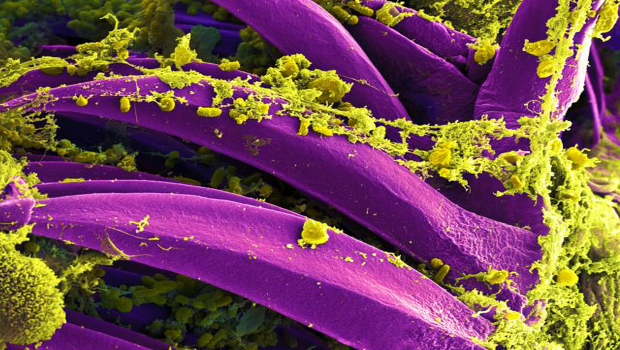MMWR Reports on 11 Human Plague Cases
A report in the CDC's Morbidity and Mortality Weekly Report (MMWR) by Natalie Kwit, DVM, and colleagues, explores the 11 cases of human plague that have been reported in residents of six states since April 1, 2015 (Arizona (two), California (one), Colorado (four), Georgia (one), New Mexico (two), and Oregon (one). The two cases in Georgia and California residents have been linked to exposures at or near Yosemite National Park in the southern Sierra Nevada Mountains of California. Nine of the 11 patients were male; median age was 52 years (range = 14–79 years). Three patients aged 16, 52, and 79 years died.


Produced by the National Institute of Allergy and Infectious Diseases (NIAID), this digitally-colorized scanning electron micrograph (SEM) depicts a number of yellow-colored Yersinia pestis bacteria that had gathered on the proventricular spines of a Xenopsylla cheopis flea. These spines line the interior of the proventriculus, a part of the flea’s digestive system. The Y. pestis bacterium is the pathogen that causes bubonic plague. Image courtesy of the CDC
A report in the CDC's Morbidity and Mortality Weekly Report (MMWR) by Natalie Kwit, DVM, and colleagues, explores the 11 cases of human plague that have been reported in residents of six states since April 1, 2015 [Arizona (two), California (one), Colorado (four), Georgia (one), New Mexico (two), and Oregon (one)]. The two cases in Georgia and California residents have been linked to exposures at or near Yosemite National Park in the southern Sierra Nevada Mountains of California. Nine of the 11 patients were male; median age was 52 years (range = 14-79 years). Three patients aged 16, 52 and 79 years died.
According to Kwit, et al. (2015), "Plague is a rare, life-threatening, flea-borne zoonosis caused by the bacterium Yersinia pestis. During 2001 through 2012, the annual number of human plague cases reported in the United States ranged from one to 17 (median = three cases). It is unclear why the number of cases in 2015 is higher than usual. Plague circulates among wild rodents and their fleas in rural and semirural areas in the western United States. Transmission to humans occurs through the bite of infected fleas, direct contact with infected body fluids or tissues, or inhalation of respiratory droplets from ill persons or animals, including ill domesticated cats and dogs. The usual incubation period between exposure and illness onset is 2-6 days."
To read further from the MMWR, CLICK HERE.
Reference: Kwit N, Nelson C, Kugeler K, et al. Human Plague - United States, 2015.
Gag Order Puts Public Health at Risk, APIC Urges Immediate Action
February 4th 2025APIC warns that the HHS gag order on CDC communications endangers public health, delaying critical infection updates and weakening outbreak response amid rising tuberculosis, avian flu, Ebola, and measles threats.
Breaking Barriers: The Future of HIV Prevention and the Fight for Widespread PrEP Access
January 31st 2025Despite medical advances, HIV prevention faces roadblocks—low PrEP adoption, stigma, and accessibility issues threaten progress. Experts push for innovative, long-acting solutions to end the epidemic.
The Hidden Dangers of Hospital Ventilation: Are We Spreading Viruses Further?
January 31st 2025New research reveals hospital ventilation and air purifiers may unintentionally spread viral particles, increasing infection risks. Infection preventionists must rethink airflow strategies to protect patients and staff.